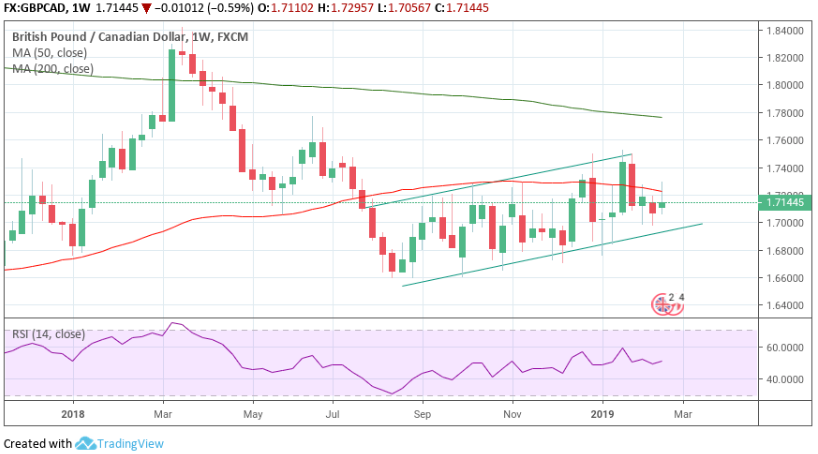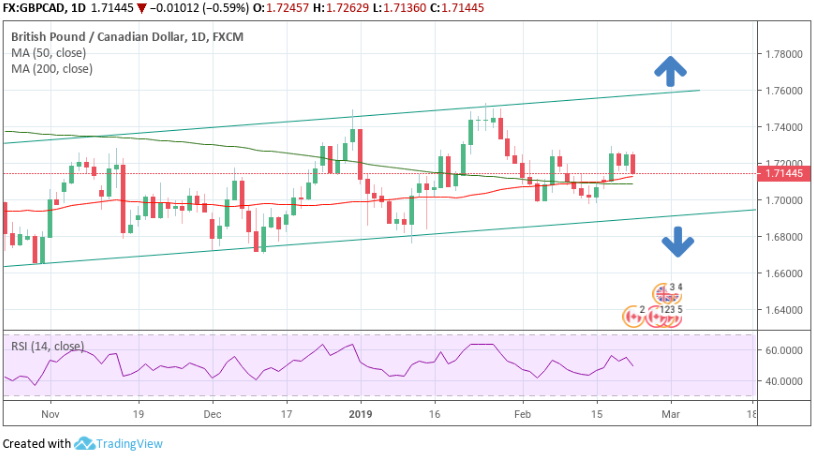The Pound-to-Canadian-Dollar Rate in the Week Ahead: Trapped Within a Multi-month Range

Image © Adobe Images
- GBPCAD rises but still stuck withinin long-term range
- Clear break from either end required for new direction.
- Brexit drives Pound as CAD eyes GDP and CPI data.
The Pound-to-Canadian Dollar rate was trading at 1.7145 Monday after rising more than 0.5% last week, but the days ahead are likely to see the pair remain within its established multi-month range pending a fundamental driver that breaks the deadlock.
Recent gains for the pair came due to signs Prime Minister Theresa May could have a better chance of getting Brexit deal through Parliament than was previously the thought, and following rumours that a three month deferral of the March 29 Brexit day is increasingly likely, seemingly voiding the possibility of a no-deal Brexit.

Above: Pound-to-Canadian-Dollar rate shown at weekly intervals.
From a technical perspective the outlook continues to be neutral because the pair remains in the middle of a long-term sideways range spanning the 1.75 to 1.68 levels. Sideways trending markets are notoriously difficult to predict and our technical stance is neutral as a result.
The 50-week moving average (MA) is currently located just above the market price and has successfully capped gains over recent weeks. It's influence is countered on the downside by the opposing force of the 50-day and 200-day averages that are providing a hard floor for the exchange rate just below the current market level.

Above: Pound-to-Canadian-Dollar rate shown at daily intervals.
A breakout above or below the parameters of the range would be necessary for the adoption of a new directional stance. Such a break would, at the very least, suggest an extension to a target generated by the breakout move - normally calculated as 61.8% of the height of the range.
Based on this a break above 1.7625 would mean a move higher toward 1.8050 while a move below 1.6775 would probably confirm a bearish leg down to somewhere around the 1.6325 level.
The Canadian Dollar: What to Watch
The two main releases for the Canadian Dollar (otherwise known as the Loonie) in the week ahead are inflation data and GDP growth rate figures. The price of Canadian Crude oil and the outlook for the U.S. - Canada's primary trading neighbour - are also influential factors.
Inflation is forecast to rise 0.1% on a monthly basis in January after suffering a -0.1% decline in December, when it is released at 14.30 GMT on Wednesday.
It is estimated to have risen by 1.4% compared to a year ago - a sizeable fall from the previous 2.0% result. Canadian inflation has declined significantly and this has pressured the Loonie; further falls would also weigh.
Lower inflation reduces the chances the Canadian central bank will raise interest rates which are a major driver of the currency. Higher interest rates generally appreciate currencies by attracting and keeping greater inflows of foreign capital, and vice versa for lower rates.
GDP data is the other key release. It is out at 14.30 on Friday and is forecast to show a -0.1% fall in December after a similar -0.1% fall was registered in November. Continued declines in GDP will raise fears the country could entering a technical recession which is defined as two consecutive quarters of negative growth.
Last week the Canadian Crude oil index rose from $42.29 to $44.50 and this probably supported the currency since higher prices increase demand for the Loonie. Further gains in crude would be an equally positive influence in the week ahead.
The Loonie could also be influenced by what happens across the border in the U.S. where a substantial amount of data is scheduled for release in the week ahead including GDP, PCE and ISM Manufacturing, as well as testimony from Federal Reserve Chairman, Jerome Powell, and the machinations of trade talks with China.
The Pound: What to Watch this Week
Brexit focus returns to Westminster this week with the Prime Minister due to make a statement in Parliament on Tuesday and an amendable motion on Brexit is up for debate on Wednesday.
The amendment to look out for is the Cooper/Letwin amendment which if passed (and a linked Bill adopted), would result in the government being directed to request an extension to the Article 50 process, should it not get a deal through Parliament by 13 March.
For Sterling such a bill makes a 'no deal' Brexit less likely on March 29, and therefore its passage would be seen as a positive for the currency.
However, a similar amendment by Cooper failed in January so parliamentarians might still be erring on the side of allowing May the freedom to get concessions from the EU before voting for such an amendment.
Last week Chancellor of the Exchequer Philip Hammond said there was the chance the second, and final, Meaningful Vote on the deal itself might actually take place this week; for this to happen some kind of concessions will need to have been secured from Brussels.
Indeed, it looks like these concessions won't be forthcoming in time for a vote this week and May has told journalists during a flight to a summit in Egypt on Sunday that she intends to hold a Meaningful Vote on the deal by March 12, just 17 days before Brexit.
“If the prime minister, Theresa May, manages to secure legal assurances from the EU on the Irish backstop, there will likely be a meaningful vote on the revised deal. But if UK-EU negotiations have not been completed by then, MPs could simply vote on an amendable motion on how to proceed next with Brexit. The latter carries the risk of Parliament voting to take control of the Brexit process, possibly forcing the government to extend Article 50, if Mrs. May has nothing to show from the latest round of talks with Brussels. Either way, the pound appears to be headed for more volatility.” Says Raffi Boyadjian, a currency analyst at XM.com.
Another key release for the UK currency, is the IHS Markit Manufacturing PMI for February, which is a survey-based activity indicator. This is out at 10.30 GMT on Friday and is forecast to show a drop to 52.0 from 52.8 in the previous month of January. PMI's are important leading indicators for the economy.
The Gfk Consumer Confidence survey is out at 1.01 early on Thursday morning and is forecast to show a -15 result from -14 previously - mainly as the mood sours over Brexit. An even sharper-than-predicted fall in the Gfk could well have negative repercussions for Sterling since declines in sentiment indicators often precede falls in the real economy.
Time to move your money? Get 3-5% more currency than your bank would offer by using the services of foreign exchange specialists at RationalFX. A specialist broker can deliver you an exchange rate closer to the real market rate, thereby saving you substantial quantities of currency. Find out more here.
* Advertisement










